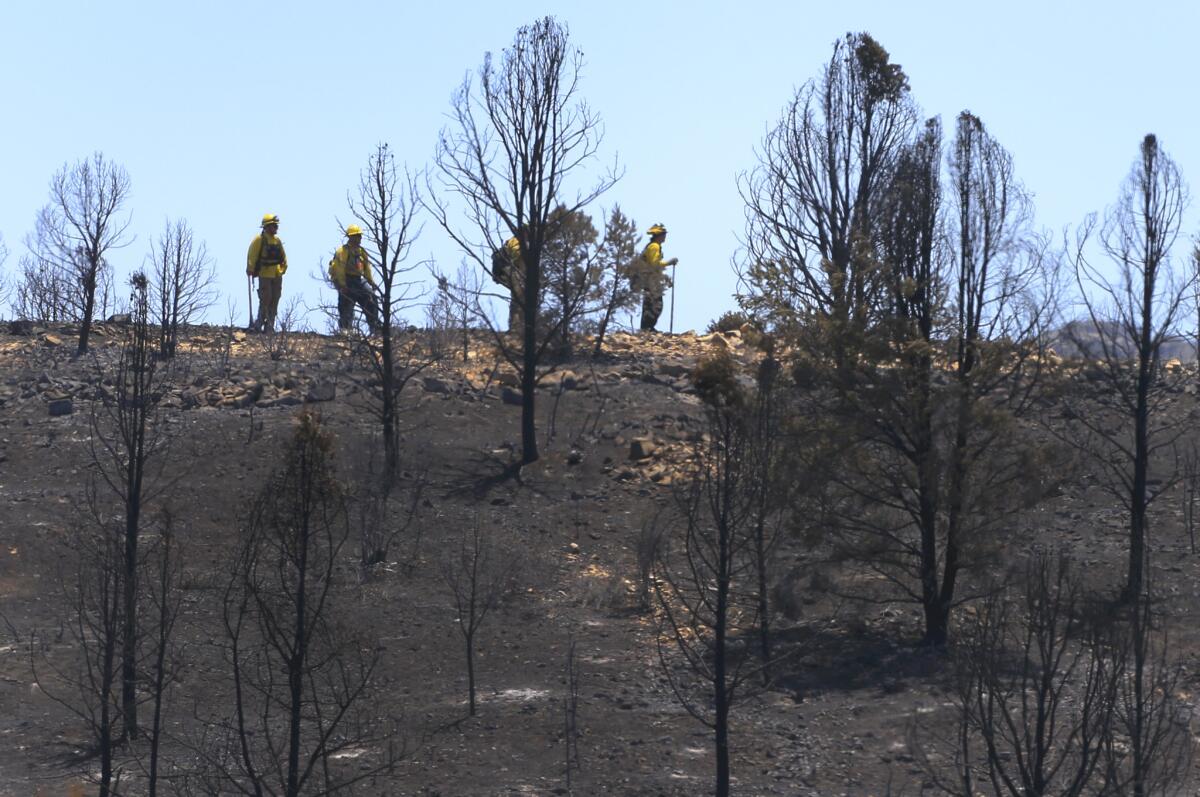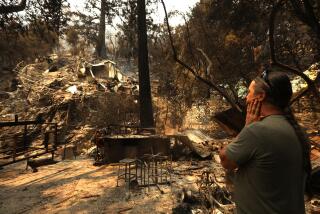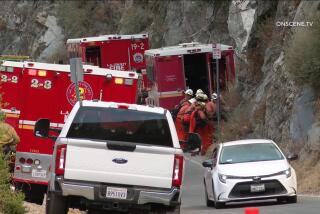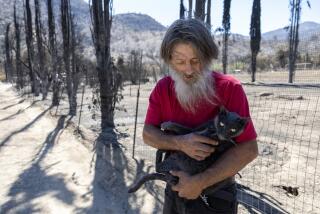Witness to Arizona wildfire: ‘It was erratic ... a freak of nature’

PRESCOTT, Ariz. - Glen Ilah was supposed to be prepared for wildfires.
Peter Andersen and his wife, Judy, toiled with their neighbors in the small Arizona subdivision about 80 miles north of Phoenix to clear defensible space around their modest ranch homes, working with prison crews to clear scrub oak and manzanita that encroached from the surrounding desert.
“We did everything we could because we knew that we were in harm’s way - we had been in a drought and we knew the fuels were there,” he said.
Andersen, 61, a burly former firefighter with a mustache and a soft spot for stray cats, also knew because for five years he had served as chief of the fire district in their town, Yarnell.
The town has a population of about 650, with about 200 of them in Glen Ilah, clustered around a turnoff south of the downtown business strip along the main artery, Highway 89.
Andersen moved to town 12 years ago from Phoenix, settling among the retirees and snow birds, watching the economy take its toll as more and more were forced to give up their summer homes among the boulders and chaparral where Andersen would rescue feral cats.
By this summer, Glen Ilah was sparsely populated, the remaining neighbors close-knit.
On Saturday, a lighting strike ignited a fire in the hills nearby, but Andersen, who retired in 2011, was oblivious. He went to get groceries in the nearest city, Wickenburg. Somebody stopped him to ask: Have they got the fire out?
Small wildfires were not unusual in the area.
That evening, Andersen and his wife drove 35 miles north to Prescott, as usual, for Bible study. On the way back, about 10:30 p.m., they saw it. The hills were glowing.
“We could see flames on the ridge” near town, he said.
He contacted local firefighters and helped crews from the Bureau of Land Management and state land and forest service to access a horse ranch to the west of Glen Ilah, where they set up a 10,000-gallon dip tank near another 5,000-gallon water tank that the rancher let them use.
They scouted the area and decided a good safety zone for firefighters to retreat to as needed would be the corral area near the tanks, about a 150-yard circle.
The next morning, Andersen watched the Granite Mountain hotshots, a local wildland firefighting team, drive their buggy by his house at 8 a.m., and figured they would be based out by the corral area, roaming down into the craggy desert land beyond that was still thick with brush - treacherous terrain full of rocks and gullies.
Andersen had attended the fire academy with the hotshots’ superintendent, Eric Marsh, and trusted him to defend the area. Marsh, a respected wildland firefighter, had started the crew in 2002.
Plus, Andersen said, “Where they were was very safe.”
As his wife was preparing to leave for work as a caregiver in Prescott, where she planned to stay overnight, she made the retired fire chief promise that if the order went out to evacuate, he would leave.
“I was pretty determined not to go,” he said.
Still, he agreed.
Then Andersen went outside and sat on a hill where he used to watch storms as a firefighter - “lightning watch,” they called it. Only this time, instead of a storm, he was watching a single-engine air tanker, a DC-10, drop slurry not once but twice onto the fire.
Andersen figured the small wildfire, which had burned about 150 acres, must be out by now.
Then came the knock at his door at 1 p.m. - time to evacuate.
“From what?” Andersen said.
Despite his promise to his wife, Andersen stayed.
About 2:30 p.m., his wife called to say it was raining in Prescott. A storm was headed for Glen Ilah.
At 4 p.m. came another evacuation order. Half an hour later, the order became mandatory in Yarnell and nearby Peeples Valley. Andersen grabbed the cat carriers, trying to herd his eight cats inside. He got all but two, Baby and Braveheart, his most recent rescue, before he was forced to flee.
Outside, the storm had flared - not rain, but wind.
“The force of the wind was so powerful, it split the fire like a horseshoe,” Andersen said. “The fire was well on its way to Peeples Valley, but when that storm hit, it split it and drove it back around areas that had already burned, toward Glen Ilah.”
He could see the fire looming to the west, a swirling black cloud.
“When I came out of the house, it looked like a tornado,” he said, “a several-foot-tall column of fire-spitting embers. The wind was hot in my face, choking smoke. It felt like a convection oven.”
Andersen had never seen a fire quite like it.
“It was erratic, it was crazy, it was a freak of nature,” he said.
The hotshots were too far away for him to see, even without the thick gray smoke. But Andersen figured they were fine, that they had retreated to the safety zone.
Andersen relied on his thick mustache to filter the smoke, got the cat carriers into the car and turned onto Highway 89, which was already blocked to the north by the fire. So he headed south through the smoky haze that stretched all 26 miles to Wickenburg, where the Red Cross set up a shelter at the high school.
Later that night, the news broke: The 19 members of the hotshot crew had died battling the blaze. From what Andersen heard, they were attempting to retreat at the urging of their lookout, the sole survivor, when they were overrun by flames and lost radio contact.
“They were a really experienced crew. They did all that they were supposed to do - it was just a freak storm,” he said.
Many from Glen Ilah worried about their homes. Anderson showed others at the shelter some Facebook photos of the area, reassuring one elderly man that his home had been saved.
On Tuesday, Andersen got a police escort back home to try to retrieve the two cats left behind.
His house, one of the closest to Highway 89, was untouched. And this time when he called, Baby and Braveheart came running.
Some of his neighbors in Glen Ilah were not so lucky.
The house next door was consumed by the fire, as were several others, the stone columns of one porch all that remained. It was, Andersen said, “like being in a war zone.”
There were rumors that he was not the only one in Glen Ilah who ignored the evacuation orders. Some feared that once officials complete a house-by-house search, they might find bodies.
But Andersen said he had checked at the shelter in Wickenburg and another in Prescott, with local fire agencies and the sheriff’s office - no one’s missing.
The people of Glen Ilah, he said, appear to have been saved.
Andersen thinks about the hotshots, an elite crew he compares to the Green Berets. He didn’t go into the fire service thinking he might die. He didn’t think the fire would flare that Sunday. He can’t imagine they did either.
“These guys were out there doing their job. They never thought they would die on this fire,” he said. “They did all that they were supposed to do - it was just a freak fire.”
ALSO:
Man with guns, armor, Molotov cocktails arrested in Seattle
Arizona wildfire: Investigators’ answers will be in the details
Woman saved from sinkhole in Toledo, Ohio, describes rescue
molly.hennessy-fiske@latimes.com
Twitter: @mollyhf
More to Read
Sign up for Essential California
The most important California stories and recommendations in your inbox every morning.
You may occasionally receive promotional content from the Los Angeles Times.











